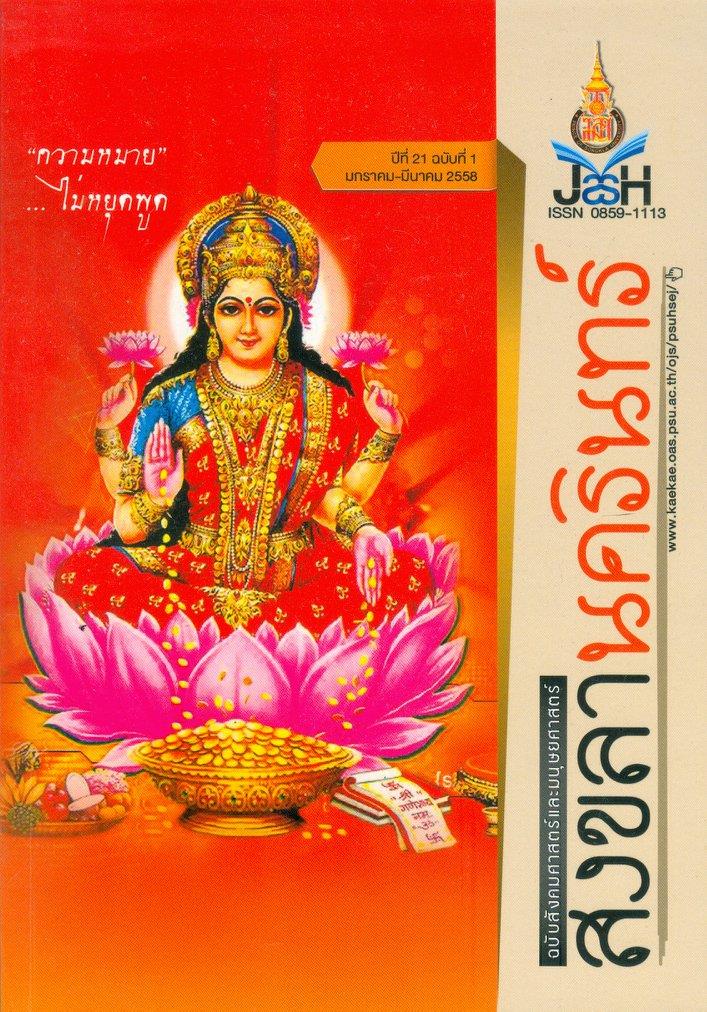<b>ความสำคัญและความหมายจากประติมานวิทยาพระลักษมีและคชลักษมีจากหลักฐานโบราณคดี</b><br> Iconographical Significance of Lakshmi and Gaja-Lakshmi Based on Archaeological Evidence
Abstract
The objective of this paper is to study concept, iconography and styles of Lakshmi and Gaja-Lakshmi in Southeast Asia based on archaeological Evidence and Hindu mythological texts. A comparison of the Indian and Southeast Asian Iconography of Lakshmi/ Gaja-Lakshmi is provided in the paper.
In primal belief of India in Goddess Lakshmi as mother of fertility, wealth and good fortune was adopted by indigenous people of ancient communities in Thailand and Cambodia. Meanwhile Lakshmi/ Gaja-Lakshmi as the goddess of agriculture and brings fertile soil to the land was recognized among people in Java (Indonesia). An iconographical depiction of Lakshmi/Gaja Lakshmi found in India is significantly comparable; such as, an icon of Lakshmi Gaja-Lakshmi who puts her left arm on her hip or seizes the cloth is similar to that of
Siri Mahamaya when she gives birth to Prince Siddhartha (the Buddha-to-be). The body of Lakshmi/Gaja Lakshmi is plump with a big chest. Later, distinctive features were introduced to create local icons of Gaja-Lakshmi. However, a significant characteristic of Gaja-Lakshmi is popularly recognized: she holds lotus in both hands and flanked by elephants.
<br><br> Keywords archaeological evidence, gaja - lakshmi, iconography, Lakshmi
<br><br>
<b> บทคัดย่อ</b><br>
บทความฉบับนี้มีวัตถุประสงค์เพื่อศึกษาและเปรียบเทียบรูปแบบลักษณะทางประติมานวิทยาของลักษมีและคชลักษมี พบในประเทศอินเดียและบางประเทศในเอเชียตะวันออกเฉียงใต้ โดยมุ่งศึกษาจากหลักฐานโบราณคดี ที่พบประติมากรรมพระลักษมีและคชลักษมีในคัมภีร์ทาง ศาสนาคติความเชื่อของพระลักษมีที่ปรากฏจากแหล่งดั้งเดิม พบว่า เมื่อแพร่หลายมายังเอเชียตะวันออกเฉียงใต้นั้น ในประเทศไทยและกัมพูชายังคงยึดถือคติดั้งเดิมคือ พระลักษมีเป็นเทพีแห่งความอุดมสมบูรณ์ ความร􀃎่ำรวยและให้โชคลาภ แต่เมื่อเข้าไปสู่ชวาแล้ว มีคติความเชื่อว่าพระลักษมีมีหน้าที่เป็นเทพีที่เกี่ยวข้องกับการเกษตรกรรม น􀃎ำความอุดมสมบูรณ์มาสู่การเพาะปลูกข้าว หมายถึงแม่โพสพ ลักษณะทางประติมานวิทยาของประติมากรรมพระลักษมีที่พบในประเทศอินเดีย ที่ส􀃎ำคัญคือ พระลักษมีเอาพระหัตถ์ซ้ายแตะที่สะโพก หรือจับชายผ้าไว้ เป็นลักษณะที่คล้ายกับประติมากรรมที่พระนางสิริมหามายาขณะทรงมีพระประสูติกาลเจ้าชายสิทธัตถะ ซึ่งต่อมา
คือพระพุทธเจ้า พระวรกายอวบ ทรวงอกขนาดใหญ่ แต่เมื่อเวลาผ่านไปและแพร่มายังกลุ่มประเทศในเอเชียตะวันออกเฉียงใต้ ก็มีการเปลี่ยนแปลงไปตามเอกลักษณ์ของเฉพาะพื้นที่ แต่ก็ยังคงลักษณะเด่นคือ พระหัตถ์ถือดอกบัวและปรากฏช้างขนาบข้าง จึงเรียกว่า คชลักษมี
<br><br> คำสำคัญ: คชลักษมี, ประติมานวิทยา, พระลักษมี, หลักฐานทางโบราณคดี











